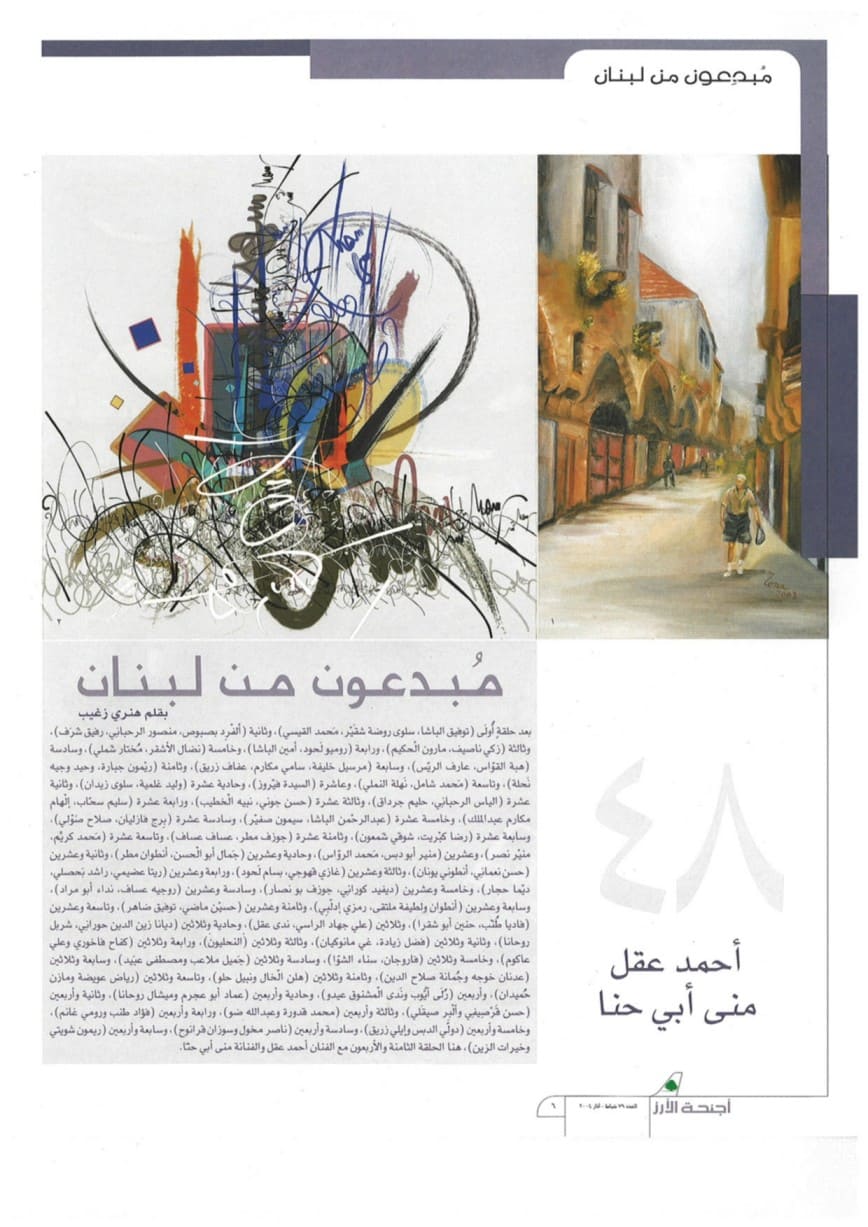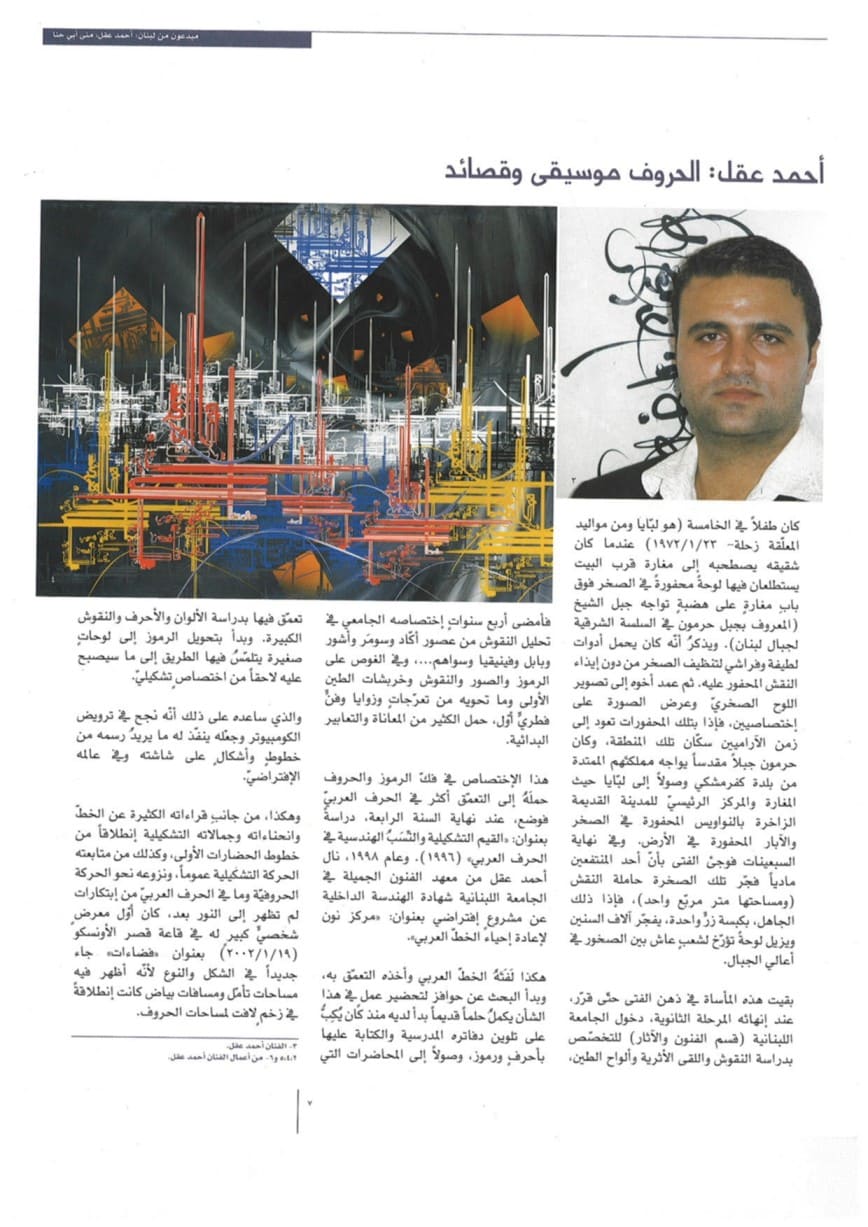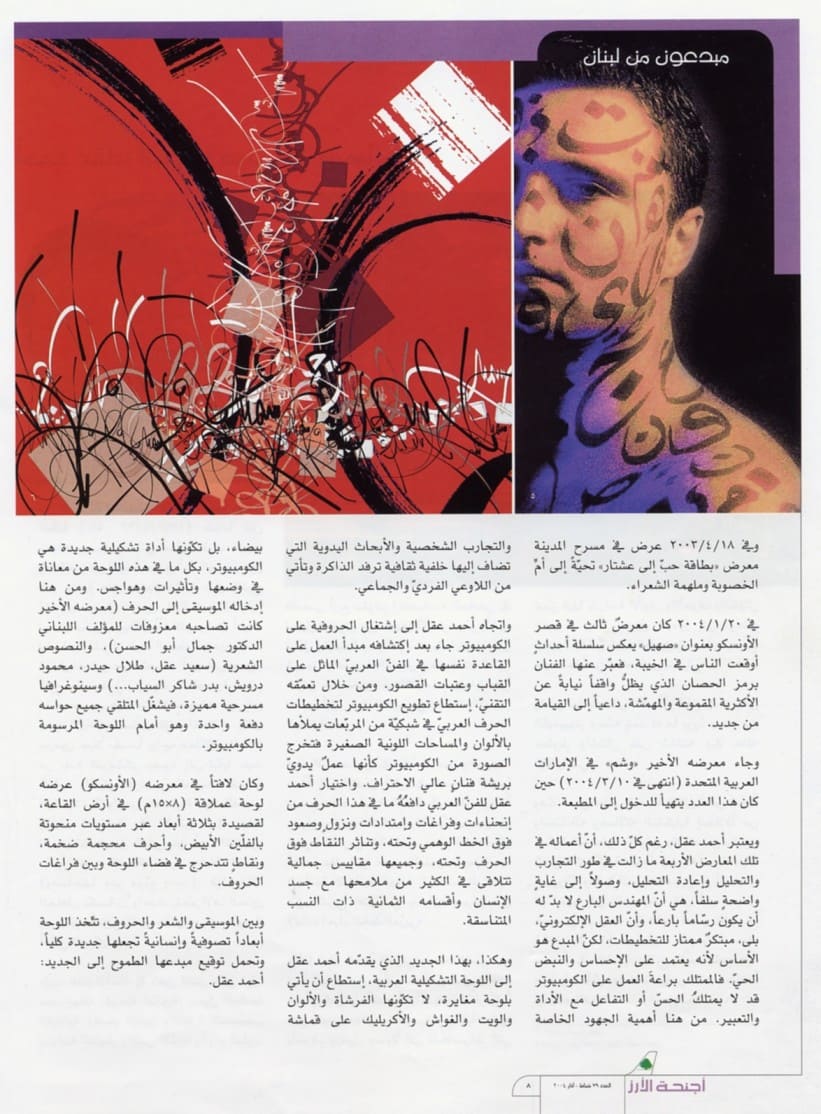

AKLART3D
Luxury Design & Build, Fit-Out, and Refurbishment Specialists.
"Legal Notice: All projects mentioned in the professional career of AKLART3D's founder, Engineer AHMAD AKL, are accurate and verified.
Eng-AKL has a distinguished and diligent career path with significant involvement in several iconic projects in the Gulf region. He played a central and essential role in all projects listed on the website, in the portfolio, or in any related publication.. "
LBCI ( Lebanese Broadcasting Corporation International ) - 18 Sep 2010
Ahmad Akl and Ramzi Azzam on LBCI (Lebanese Broadcasting Corporation International). Featured on the program Naharokom Saeed with journalist Mai Matta in the AGENDA segment, covering their shared experience, Dream. Additionally, a joint discussion on poetry and calligraphy with journalist Rony Ziadeh in the When We Write segment.
Home > AKL ART
AKLART - Press Release
Creative Minds from Lebanon | Wings of the Cedar – Issue 79 – February 2004 | By Henry Zgheib
Creative Minds from Lebanon”
By Henry Zgheib | Creative Minds from Lebanon | Wings of the Cedar – Issue 79 – February 2004 |
After the first episode (Tawfiq Al‑Basha, Salwa Rauda Shaqir, Muhammad Al‑Qaysi), the second (Alfred Basbous, Mansour Rahbani, Rafiq Sharaf), the third (Zaki Nassif, Maroun Al‑Hakim), the fourth (Romeo Lahoud, Amin Al‑Basha), the fifth (Nidal Al‑Ashkar, Mukhtar Shumli), the sixth (Hiba Al‑Qawwas, Aref Al‑Rayyes), the seventh (Marcel Khalife, Sami Makarem, Afaf Zreik), the eighth (Raymond Jabbara, Wahid Wajih Nahleh), the ninth (Mohammad Shamil, Nahla Al‑Nemli), the tenth (Fairuz), the eleventh (Walid Ghalmeia, Salwa Zidan), the twelfth (Elias Rahbani, Halim Jurdak), the thirteenth (Hassan Jouni, Nabih Al‑Khatib), the fourteenth (Salim Sahhab, Ilham Makarem Abdul‑Malik), the fifteenth (Abdul‑Rahman Al‑Basha, Simon Safir), the sixteenth (Burg Fazlian, Salah Souli), the seventeenth (Reda Kabbara, Shawki Shamoun), the eighteenth (Joseph Mattar, Assaf Assaf), the nineteenth (Mohammad Karim, Munir Nasr), the twentieth (Munir Abu Dabbus, Mohammad Al‑Ruwais), the twenty-first (Jamal Abu Al‑Hasan, Antoine Mattar), the twenty-second (Hassan Ne‘mani, Anthony Younan), the twenty-third (Ghazi Qahouji, Bassam Lahoud), the twenty-fourth (Reina Agheemi, Rashid Bahsali, Dima Hijar), the twenty-fifth (David Korany, Joseph Bu Nassar), the twenty-sixth (Roger Assaf, Nidaa Abu Murad), the twenty-seventh (Antoine & Latifa Multaqa, Ramzi Idlibi), the twenty-eighth (Hussein Madi, Tawfiq Daher), the twenty-ninth (Fadia Tonb, Haneen Abu Shaqra), the thirtieth (Ali Jihad Al‑Rassi, Nada Aql), the thirty-first (Diana Zainuddin Hurani, Charbel Rouhana), the thirty-second (Fadhl Ziyada, Guy Manoukian), the thirty-third (Al‑Nahliyyun), the thirty-fourth (Kifah Fakhoury & Ali Akoum), the thirty-fifth (Faroujan, Sanaa Al‑Shawa), the thirty-sixth (Jamil Mala‘eb & Mustafa Obeid), the thirty-seventh (Adnan Khawaja & Jumana Salah Al‑Din), the thirty-eighth (Helen Khalloul & Nabil Hano), the thirty-ninth (Riad Oweida & Mazen Hamdan), the fortieth (Rola Ayoub & Nada Al‑Meshnoq‑Aidoo), the forty-first (Imad Abu Ajram & Michel Rouhana), the forty-second (Hassan Qarssifi & Albert Sayigh), the forty-third (Mohammad Qaddura & Abdullah Dou), the forty-fourth (Fuad Tonb & Roumi Ghanem), the forty-fifth (Doli Al‑Dibs & Elie Zreik), the forty-sixth (Nasser Makhoul & Suzanne Qaranooh), the forty-seventh (Raymond Shweiti & Khairat Al‑Zein).
Here is the forty-eighth episode, featuring Ahmad Aql and Muna Abi Hanna.
Ahmad Aql: “Letters, Music & Poetry”
-
Childhood Inspiration:
Born in Labbaya (near Zahlé) on January 23, 1972, he was five when his older brother took him to a nearby cave. They discovered an Aramaic carving above the entrance—precisely cleaned by Ahmad with brushes. Later, his brother photographed it and experts confirmed it dated to the Aramaean era. The ancient mountain of Hermon (then called Har‑hermon), overlooking their village, had been sacred. A wealthy individual later destroyed that carved rock (about 1 m²), erasing millennia of heritage. -
Academic Path:
The tragedy stayed with him; after finishing high school, he joined the Lebanese University’s Department of Arts and Antiquities. He spent four years studying inscriptions and artifacts from Akkadian, Sumerian, Assyrian, Babylonian, Phoenician and other civilizations—decoding symbols, images, and early clay scribbles. -
Arabic Calligraphy & Design:
His research culminated in 1996 with a study titled “Formative Values and Geometric Proportions in Arabic Calligraphy.” In 1998, he earned a degree in interior design from the Fine Arts Institute at Lebanese University, presenting the virtual project “Noon Center for Reviving Arabic Script.” -
Digital-Art Fusion:
Aql merged ancient calligraphy with digital tools, creating computer-generated artworks that mimic hand-painted Arabic letters within grids—colors and shapes flowing like traditional art but crafted digitally. He emphasized that while computers aid invention, true creativity stems from human sensitivity and engagement. -
Exhibitions:
-
January 19, 2002: “Spaces” at UNESCO Palace—an innovative solo show blending empty spaces and letter forms.
-
April 18, 2003: “A Love Letter to Ishtar” at Théâtre de la Ville—homage to the Mesopotamian goddess of fertility and arts.
-
January 20, 2004: “Saehel” at UNESCO Palace—used the horse motif to express collective suffering and resilience.
-
March 10, 2004: “Tashm” (Tattoo) at a UAE gallery—featured at the time of this article’s publication.
-
-
Artistic Vision:
Ahmad views his work as “ongoing experiments.” He believes interior-spatial design equals painting skill, and that computers craft layouts but human artists imbue life and meaning. His art combines music—often live oud compositions by Dr. Jamal Abu Al‑Hasan—with poetry by Said Aql, Talal Haydar, Mahmoud Darwish, Badr Shakir Al‑Sayab and staged scenography. Displayed was an 8 × 15 m floor installation featuring a three-dimensional poem built of cork and large letters, dotted with cascading text—the whole reflecting mystical and human dimensions, true to his creative signature.









